Abstract
Clark, Harold W. (The George Washington University, Washington, D.C.), Jack S. Bailey, Richard C. Fowler, and Thomas McP. Brown. Identification of Mycoplasmataceae by the fluorescent antibody method. J. Bacteriol. 85:111–118. 1963.—The conditions of the fluorescent antibody reactions were studied in relation to their application to Mycoplasmataceae or pleuropneumonia-like organisms (PPLO). Mycoplasma hominis type 1 and 2 antigens and their homologous antisera were used to determine the activity and specificity of these and other strains. Fluorescein isothiocyanate conjugated antiserum globulin preparations were used in both the direct and indirect fluorescent antibody methods. A direct tube technique was used for the detection and measurement of growth in broth cultures by the addition of conjugated antiserum. The specific fluorescent staining and recognition of hot water fixed M. hominis colonies was presented as a suitable identification standard. The antigenic activity was found to remain in the insoluble residue after exposure of M. hominis strains to sonic vibration (9 kc) for 30 min and centrifugation. Brief 2-min exposures of tissue cells to vibration (9 kc) caused the disruption of tissues, with the release of viable and “bound” nonwashable strains that reacted specifically with fluorescent antibody. It is proposed to apply both the sonic vibration and the fluorescent antibody techniques for the identification of Mycoplasmataceae in human tissues.
Full text
PDF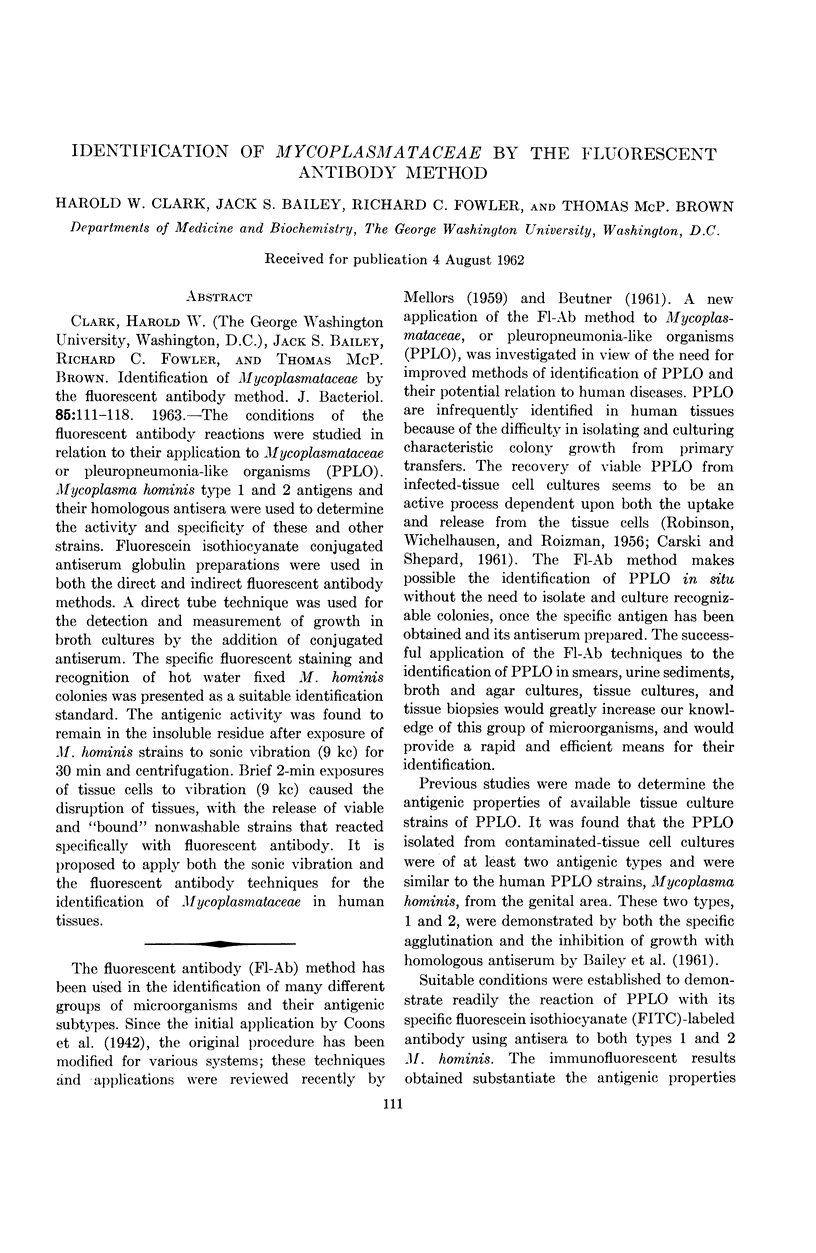



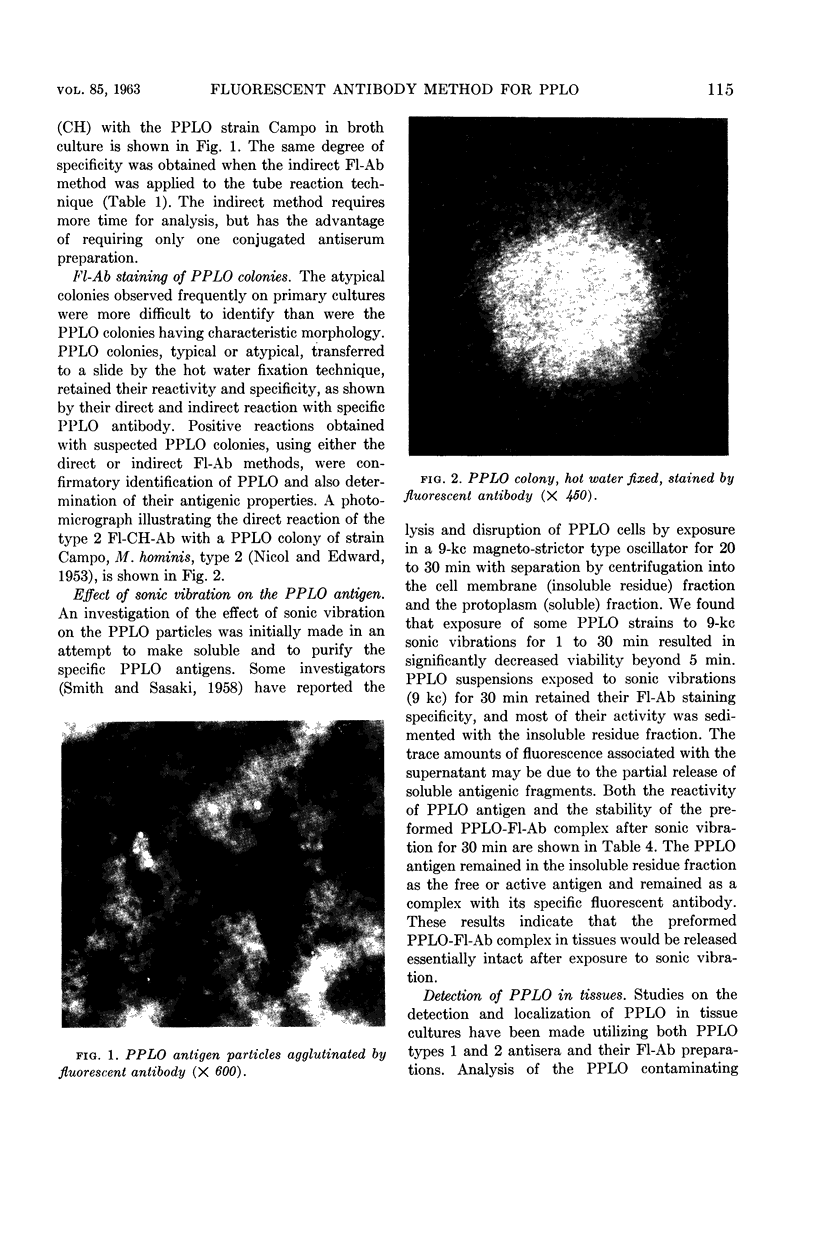
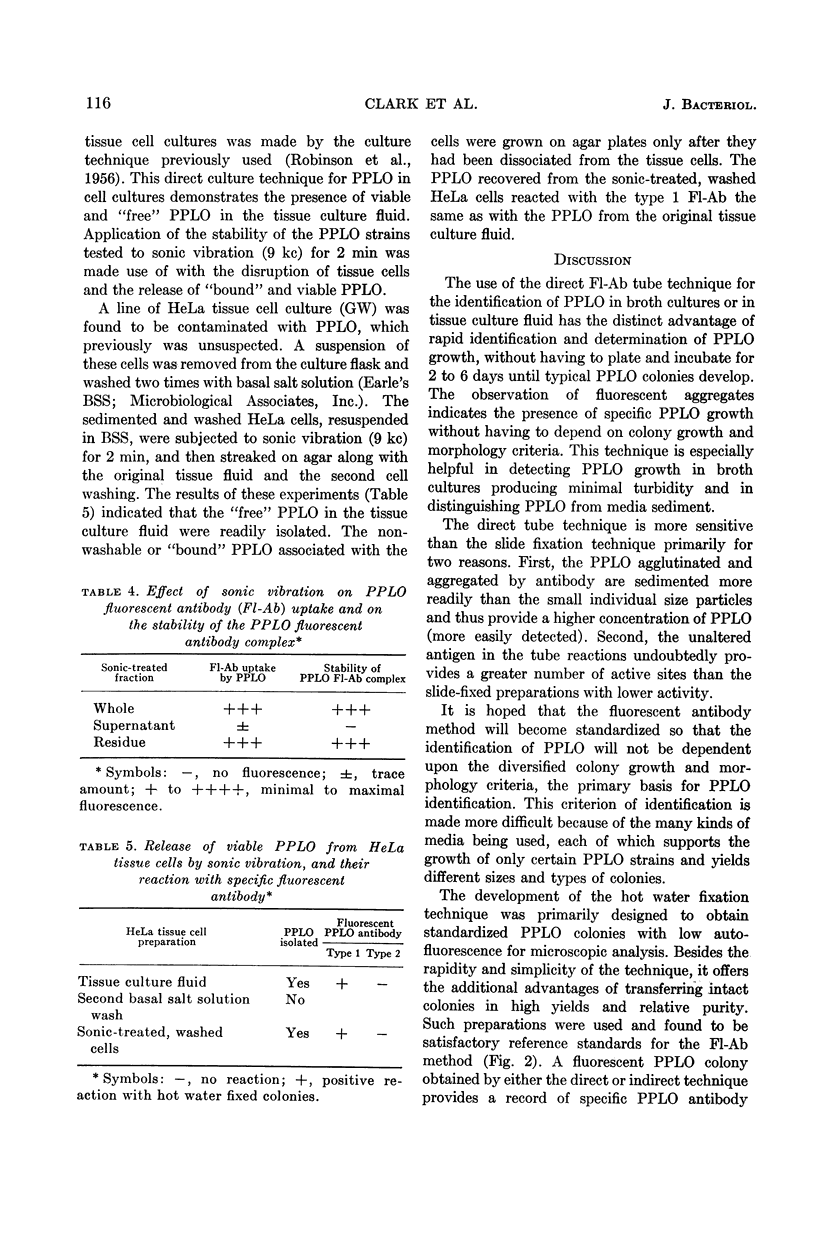
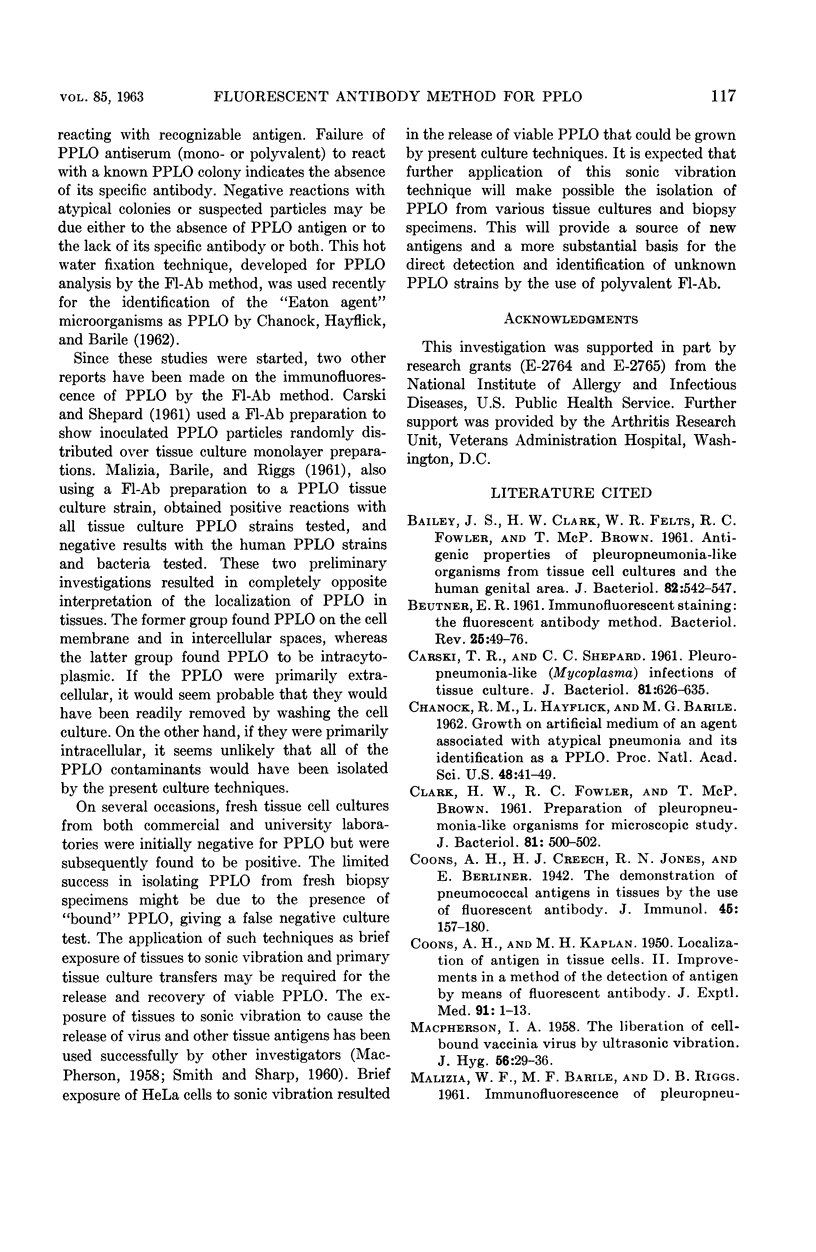
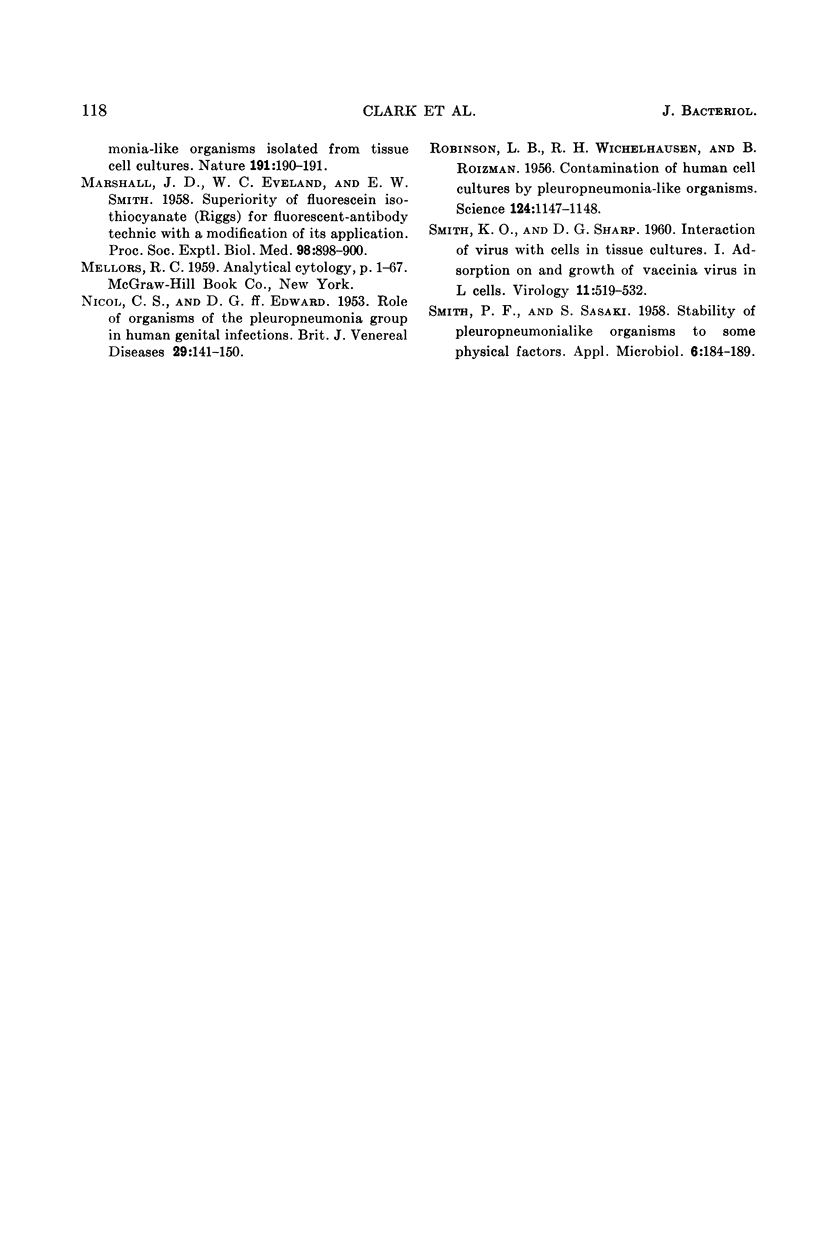
Images in this article
Selected References
These references are in PubMed. This may not be the complete list of references from this article.
- BAILEY J. S., CLARK H. W., FELTS W. R., FOWLER R. C., BROWN T. M. Antigenic properties of pleuropneumonia-like organisms from tissue cell cultures and the human genital area. J Bacteriol. 1961 Oct;82:542–547. doi: 10.1002/path.1700820236. [DOI] [PMC free article] [PubMed] [Google Scholar]
- Beutner E. H. IMMUNOFLUORESCENT STAINING: THE FLUORESCENT ANTIBODY METHOD. Bacteriol Rev. 1961 Mar;25(1):49–76. doi: 10.1128/br.25.1.49-76.1961. [DOI] [PMC free article] [PubMed] [Google Scholar]
- CARSKI T. R., SHEPARD C. C. Pleuropneumonia-like (mycoplasma) infections of tissue culture. J Bacteriol. 1961 Apr;81:626–635. doi: 10.1128/jb.81.4.626-635.1961. [DOI] [PMC free article] [PubMed] [Google Scholar]
- CHANOCK R. M., HAYFLICK L., BARILE M. F. Growth on artificial medium of an agent associated with atypical pneumonia and its identification as a PPLO. Proc Natl Acad Sci U S A. 1962 Jan 15;48:41–49. doi: 10.1073/pnas.48.1.41. [DOI] [PMC free article] [PubMed] [Google Scholar]
- CLARK H. W., FOWLER R. C., BROWN T. M. Preparation of pleuropneumonia-like organisms for microscopic study. J Bacteriol. 1961 Mar;81:500–502. doi: 10.1128/jb.81.3.500-502.1961. [DOI] [PMC free article] [PubMed] [Google Scholar]
- COONS A. H., KAPLAN M. H. Localization of antigen in tissue cells; improvements in a method for the detection of antigen by means of fluorescent antibody. J Exp Med. 1950 Jan 1;91(1):1–13. doi: 10.1084/jem.91.1.1. [DOI] [PMC free article] [PubMed] [Google Scholar]
- MACPHERSON I. A. The liberation of cell-bound vaccinia virus by ultrasonic vibration. J Hyg (Lond) 1958 Mar;56(1):29–36. doi: 10.1017/s0022172400037529. [DOI] [PMC free article] [PubMed] [Google Scholar]
- MARSHALL J. D., EVELAND W. C., SMITH C. W. Superiority of fluorescein isothiocyanate (Riggs) for fluorescent-antibody technic with a modification of its application. Proc Soc Exp Biol Med. 1958 Aug-Sep;98(4):898–900. doi: 10.3181/00379727-98-24222. [DOI] [PubMed] [Google Scholar]
- NICOL C. S., EDWARD D. G. Role of organisms of the pleuropneumonia group in human genital infections. Br J Vener Dis. 1953 Sep;29(3):141–150. doi: 10.1136/sti.29.3.141. [DOI] [PMC free article] [PubMed] [Google Scholar]
- ROBINSON L. B., WICHELHAUSEN R. H. Contamination of human cell cultures by pleuropneumonialike organisms. Science. 1956 Dec 7;124(3232):1147–1148. doi: 10.1126/science.124.3232.1147. [DOI] [PubMed] [Google Scholar]
- SMITH K. O., SHARP D. G. Interaction of virus with cells in tissue cultures. I. Adsorption on and growth of vaccinia virus in L cells. Virology. 1960 Jul;11:519–532. doi: 10.1016/0042-6822(60)90097-0. [DOI] [PubMed] [Google Scholar]
- SMITH P. F., SASAKI S. Stability of pleuropneumonialike organisms to some physical factors. Appl Microbiol. 1958 May;6(3):184–189. doi: 10.1128/am.6.3.184-189.1958. [DOI] [PMC free article] [PubMed] [Google Scholar]




